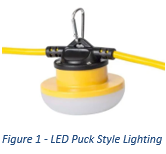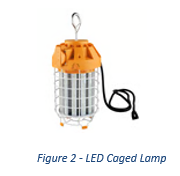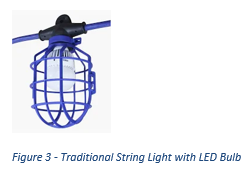“LED lights & protecting temporary lights against accidental contactor breakage.”
This article will address the prevalence of LED lighting on construction sites and some common misconceptions with OSHA standard 1926.405(a)(2)(ii)(E) that requires temporary lights in construction to be protected against accidental contact or breakage.
OSHA’s requirements for protecting temporary lighting protection are as follows:
All lamps for general illumination shall be protected from accidental contact or breakage. Metal-case sockets shall be grounded.
However, OSHA does not address LED lighting and how these devices are utilized on construction sites. LEDs have transformed the lighting industry. They have a longer lifespan, are more efficient, and are better for the environment. They also add another important benefit to our sites, in that they are typically made of plastic/epoxy rather than traditional glass. OSHA has been slow to adopt regulations that reference these types of LED lights and as such it is open to interpretation on whether a condition is citable or not when utilizing this equipment in regards to accidental contact or breakage.
Let’s review a few of the more prevalent types of LED lights that are currently used on construction sites across the United States.
   |
LED Puck Style Lighting - LED integrated string lights are durable enough to withstand the rigors of a construction site. Each light only consumes 13-watts of power while having 1600 lumens. Construction grade temporary string lights are manufactured with 18/2 SJTW cable and NEMA 5-15 molded plug and connector ends. Rated for outdoor use and is cETLus listed and OSHA and NEC compliant.
LED Caged Lamp - This light features a hollow heat sink an electrolytic stainless steel guard and a 10 ft. power cord with 6000V surge protection. It also has silicone gaskets making it suitable for use in damp locations. It provides bright worksite lighting with a 7200 lumen output and 5000K daylight color temperature. Rated for outdoor use and is cETLus listed and OSHA and NEC compliant
“Traditional” String Light with LED Bulb - Temporary LED Lighting String Light System is designed for high output illumination and daisy chain connections across a total length of 250` away from the power source. The 10 watt LED lamps on this this work site light set provide more and higher quality light than 100 wattage incandescent lights while creating less heat and using less power. This LED light stringer operates on 277V AC and provides operators with a temporary work light solution for tunnels and underpasses up to half a mile in length.
What is the misconception you might ask? For both the puck style and the caged lamps the manufacturer has either built in a cage or excluded any additional protective measures with the purchased lights. Since OSHA has failed to address LED plastic/epoxy lighting we could then refer back to the manufacturer’s instructions for use and make a valid argument that these systems both the meet the 1926.405(a)(2)(ii)(E) OSHA standard.
Conversely, while the LED lights in the conventional stringer systems are made of similar plastic/epoxy material, when purchased, cage baskets are included and recommended to be used by the manufacturer. HERE IS THE MISCONCEPTION – Electrical trades people that are installing these lights and maintaining them through the duration of the project are under the impression that these lights do not need to be caged.
While the argument could be made and possibly be successful with OSHA if cited, this would likely take significant time and efforts and still may lead to a citation. OSHA would likely refer back to the manufacturer’s instructions for use, which would be difficult to argue against.
OSHA is likely, at some point in the future, to address this issue through an interpretation letter. However, in the meantime if you are on a site in which LED’s are in use it is recommended to ensure that they are being installed and maintained per OSHA regulations & manufacturers recommendations. Therefore, both the puck style and the caged lamp style are much easier to maintain as the absence of removal baskets are not in play.
Related Topics: Jobsite Safety, Monthly Safety Topics, Workplace Safety, Safety Tips, Safety Awareness, Construction Safety